Who Are Scientists?

Scientists collecting water samples (Unya-MT, iStockphoto)

Scientists collecting water samples (Unya-MT, iStockphoto)
How does this align with my curriculum?
| Grade | Course | Topic |
|---|
Students will explore, and reflect on, their perceptions of science and scientists.
Overview
| Activities | Timing | Student Grouping | Description |
|---|---|---|---|
| Minds-On: Visualizing scientists at work | 1 - 5 minutes | Independent | Students visualize and make notes about what they think a scientist doing science looks like. |
| Action: Drawing scientists at work | 30 - 40 minutes | Independent, Small group | Students draw what they have visualized, analyze their drawings, and discuss their results. |
| Consolidation: I Used to Think, Now I Think | 20-30 minutes | Independent | Students reflect on what they have learned in this lesson. |
Students will:
- Reflect on personal conceptions of what scientists do and where they work.
- Recognize that anyone interested in science, regardless of gender, socio-economic status, or cultural background, can pursue a career in science.
- Expand knowledge of the variety of jobs/careers that require or benefit from a background in science.
Learning Goals
Students will:
- Reflect on personal conceptions of what scientists do and where they work.
- Recognize that anyone interested in science, regardless of gender, socio-economic status, or cultural background, can pursue a career in science.
- Expand knowledge of the variety of jobs/careers that require or benefit from a background in science.
Students can:
- List ways in which their personal conception of scientists or science jobs has changed after completing the activities
- Name 5 or more science-related jobs/careers
- Articulate that science-related jobs/careers are not limited by gender, socio-economic status, or cultural background.
Success Criteria
Students can:
- List ways in which their personal conception of scientists or science jobs has changed after completing the activities
- Name 5 or more science-related jobs/careers
- Articulate that science-related jobs/careers are not limited by gender, socio-economic status, or cultural background.
This icon indicates potential assessment opportunities.
Observations
- Observe student’s level of engagement and participation in the creation of their drawings (Action)
- Observe student’s contributions as they share and discuss the content of their own, and others’, drawings (Action)
Conversations
- Listen to student’s discussions about their, and their classmates’, drawing for appropriate comments and responses to questions posed (Action)
- Have conversations with students about their thinking related to who scientists are, what they do, and where they work (Action)
Products
- Review the Analyzing our Drawings recording sheet for students’ analysis of their drawings (Action)
- Review the I Used to Think, Now I Think recording sheet for appropriate conclusions (Consolidation)
Evidence of Student Learning
This icon indicates potential assessment opportunities.
Observations
- Observe student’s level of engagement and participation in the creation of their drawings (Action)
- Observe student’s contributions as they share and discuss the content of their own, and others’, drawings (Action)
Conversations
- Listen to student’s discussions about their, and their classmates’, drawing for appropriate comments and responses to questions posed (Action)
- Have conversations with students about their thinking related to who scientists are, what they do, and where they work (Action)
Products
- Review the Analyzing our Drawings recording sheet for students’ analysis of their drawings (Action)
- Review the I Used to Think, Now I Think recording sheet for appropriate conclusions (Consolidation)
Students will:
- Reflect on personal conceptions of what scientists do and where they work.
- Recognize that anyone interested in science, regardless of gender, socio-economic status, or cultural background, can pursue a career in science.
- Expand knowledge of the variety of jobs/careers that require or benefit from a background in science.
Learning Goals
Students will:
- Reflect on personal conceptions of what scientists do and where they work.
- Recognize that anyone interested in science, regardless of gender, socio-economic status, or cultural background, can pursue a career in science.
- Expand knowledge of the variety of jobs/careers that require or benefit from a background in science.
Students can:
- List ways in which their personal conception of scientists or science jobs has changed after completing the activities
- Name 5 or more science-related jobs/careers
- Articulate that science-related jobs/careers are not limited by gender, socio-economic status, or cultural background.
Success Criteria
Students can:
- List ways in which their personal conception of scientists or science jobs has changed after completing the activities
- Name 5 or more science-related jobs/careers
- Articulate that science-related jobs/careers are not limited by gender, socio-economic status, or cultural background.
This icon indicates potential assessment opportunities.
Observations
- Observe student’s level of engagement and participation in the creation of their drawings (Action)
- Observe student’s contributions as they share and discuss the content of their own, and others’, drawings (Action)
Conversations
- Listen to student’s discussions about their, and their classmates’, drawing for appropriate comments and responses to questions posed (Action)
- Have conversations with students about their thinking related to who scientists are, what they do, and where they work (Action)
Products
- Review the Analyzing our Drawings recording sheet for students’ analysis of their drawings (Action)
- Review the I Used to Think, Now I Think recording sheet for appropriate conclusions (Consolidation)
Evidence of Student Learning
This icon indicates potential assessment opportunities.
Observations
- Observe student’s level of engagement and participation in the creation of their drawings (Action)
- Observe student’s contributions as they share and discuss the content of their own, and others’, drawings (Action)
Conversations
- Listen to student’s discussions about their, and their classmates’, drawing for appropriate comments and responses to questions posed (Action)
- Have conversations with students about their thinking related to who scientists are, what they do, and where they work (Action)
Products
- Review the Analyzing our Drawings recording sheet for students’ analysis of their drawings (Action)
- Review the I Used to Think, Now I Think recording sheet for appropriate conclusions (Consolidation)
Materials and Preparation
| Material/Technology/Setting | Quantity |
|---|---|
|
1 per student |
|
Shared |
|
Teacher Use |
Materials
| Material/Technology/Setting | Quantity |
|---|---|
|
1 per student |
|
Shared |
|
Teacher Use |
- Ensure students have materials to make their drawings.
Preparation
- Ensure students have materials to make their drawings.
- General understanding that studying science can lead to a job or career.
Student Prior Knowledge and Skills
- General understanding that studying science can lead to a job or career.
| Material/Technology/Setting | Quantity |
|---|---|
|
1 per student |
|
Shared |
|
Teacher Use |
Materials
| Material/Technology/Setting | Quantity |
|---|---|
|
1 per student |
|
Shared |
|
Teacher Use |
- Ensure students have materials to make their drawings.
Preparation
- Ensure students have materials to make their drawings.
- General understanding that studying science can lead to a job or career.
Student Prior Knowledge and Skills
- General understanding that studying science can lead to a job or career.
Teaching and Learning Activities
This icon indicates potential assessment opportunities
Minds-On: Visualizing scientists at work (1 - 5 min.)
| Instructions | Teaching Tips |
|---|---|
|
Ask students to close their eyes and try to picture a scientist at work doing science. They should not share their visualizations with others. To have students think about this person in more detail, ask questions such as:
Remind students to keep their ideas to themselves. |
You can repeat the questions but do not provide any suggestions or embellishments that might direct their thinking. |
Action: Drawing scientists at work (30 - 40 min.)
| Instructions | Teaching Tips |
|---|---|
|
Still keeping their ideas to themselves, have students open their notebooks to a new page or provide them with a blank sheet of paper. Ask them to make a drawing of the scientist they imagined using as much detail as possible. |
IdeaBe careful not to lead students to think in a particular direction. Simply state the instruction: “Make a drawing of a scientist doing science.” Refrain from adding any elaborations or suggestions. LanguageStudents could write a description to summarize the content of their drawing. |
|
After they have completed their drawings, have students form groups of three or four. In their groups, each student will present and describe their drawings. Students could do a gallery walk to see what others have drawn. Lead a brief discussion about what they saw in the drawings their peers drew using question prompts like the ones on the right. |
DiscussionsDiscussion prompts can include:
|
|
Provide each student with a copy of the Analyzing our Drawings reproducible [Google doc] [Word doc] [PDF]. Have them complete the table for their own drawing only. 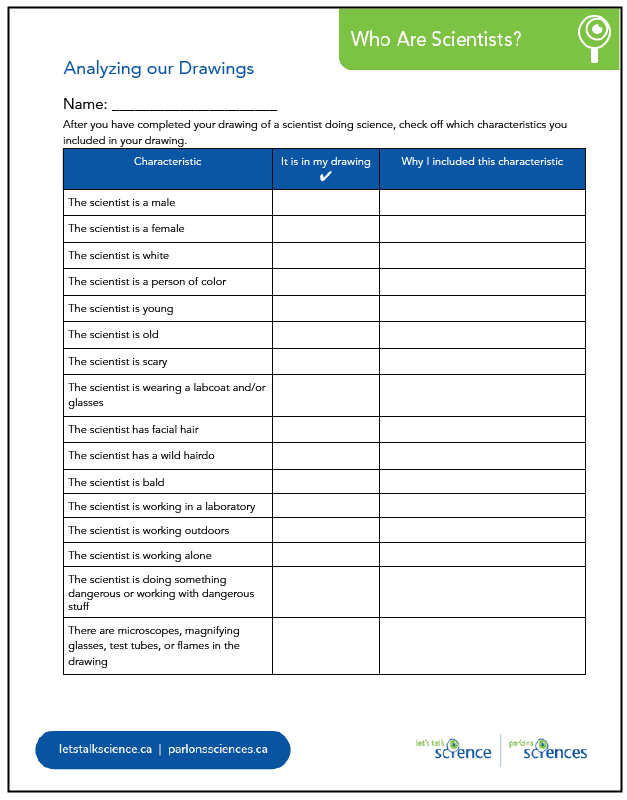 Analyzing our Drawings reproducible (©2023 Let’s Talk Science). Create a copy of the table on chart paper, a whiteboard, or digitally. Using a show of hands, record the number of instances of each characteristic students used in their drawings. Using a think-pair-share strategy, have students first observe the class data. Ask them to look for any patterns or trends they see in the data. Are there any trends? Can they draw any conclusions from these data? Then, have students share their thoughts about the data with a partner. |
IdeaFor younger students, draw the table on a whiteboard or chart paper and record students' responses as you ask for a show of hands. Community ConnectionsIt is important to note that the content of students’ drawings will come from their prior knowledge and personal background. As you probe the source of students’ ideas in the next section, it is important to do so in a non-judgemental way. The goal is to help students recognize the sources of their preconceptions and to help them see beyond these initial ideas. |
| Next, lead a class discussion about possible trends in the class data. Invite students to describe any trends or commonalities they see in the data (i.e., the instances of each characteristic). |
IdeaIf students miss any trends that show up in the data, bring their attention to the data and help them identify the trend(s) they missed. |
|
As trends are described, ask students to pose reasons for the trends they have identified. For example, if the class drew more male scientists than females, ask them why they think this trend occurred. Ask them about where they think their ideas about the characteristics of, or the work done by, scientists comes from? If necessary, introduce the concepts of a stereotype as an overgeneralized belief about a particular group of people, which can lead us to make assumptions about individuals without really knowing much about them. Help students recognize that stereotypes often arise unconsciously as we try to make sense of our world and that there are advantages and disadvantages to stereotypes. Refer to the Key Ideas for Class Discussion teacher reference [Google doc] [Word doc] [PDF] for key points to bring out with students during this lesson. |
DiscussionsDiscussion prompts can include:
|
Consolidation: I Used to Think, Now I Think (10 - 15 min.)
| Instructions | Teaching Tips |
|---|---|
|
Provide each student with a copy of the I Used to Think, Now I Think reproducible [Google doc] [Word doc] [PDF]. 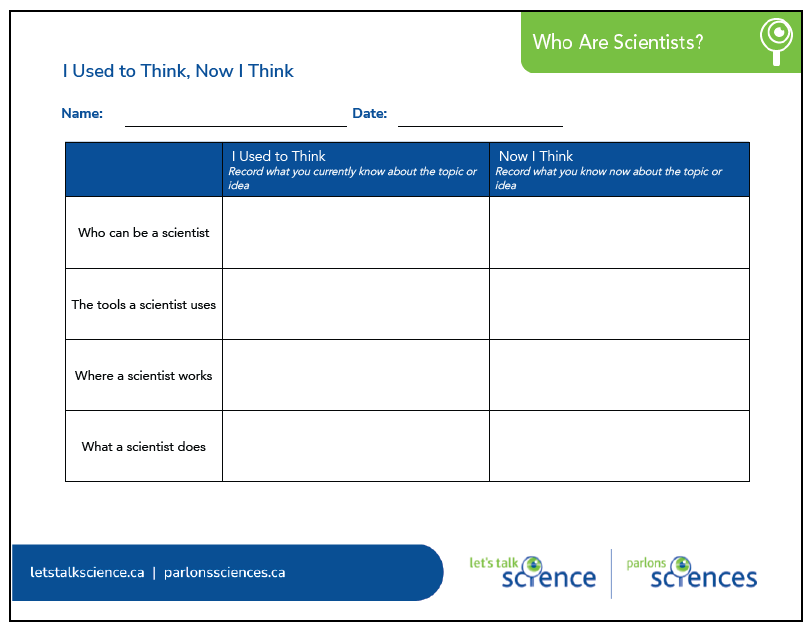 I Used to think, Now I think reproducible (©2023 Let’s Talk Science). Ask students to reflect on what they have learned about scientists compared to their original thoughts and drawings. For each of the four criteria on the chart, have them indicate their original thinking in the left column and their current thinking in the right column. If their current thinking is the same as their original thinking, have them use the space in the table to describe why it is the same. |
IdeaThe “I Used to think, Now I think” activity can be completed as a whole class. Alternatively, students could complete the table and then share the parts with which they are comfortable sharing, with a partner (i.e., Think-Pair-Share). |
Background Information for Teachers
Childrens’ Perceptions of Science and Scientists
The views students have about what scientists look like, the type of work they do, and who becomes a scientist, are often very narrow. These views are based on stereotypes that have existed in our society for many years. This stereotypical view sees scientists a white males, who work alone, usually in a lab, with test tubes, chemicals, and open flames.
Such views can make it difficult for students to see themselves as someone to whom science matters; certainly not as an area where they would work. While we do not teach science curriculum to create more scientists, the reality is that many current and future careers require, or benefit from, a background in science.
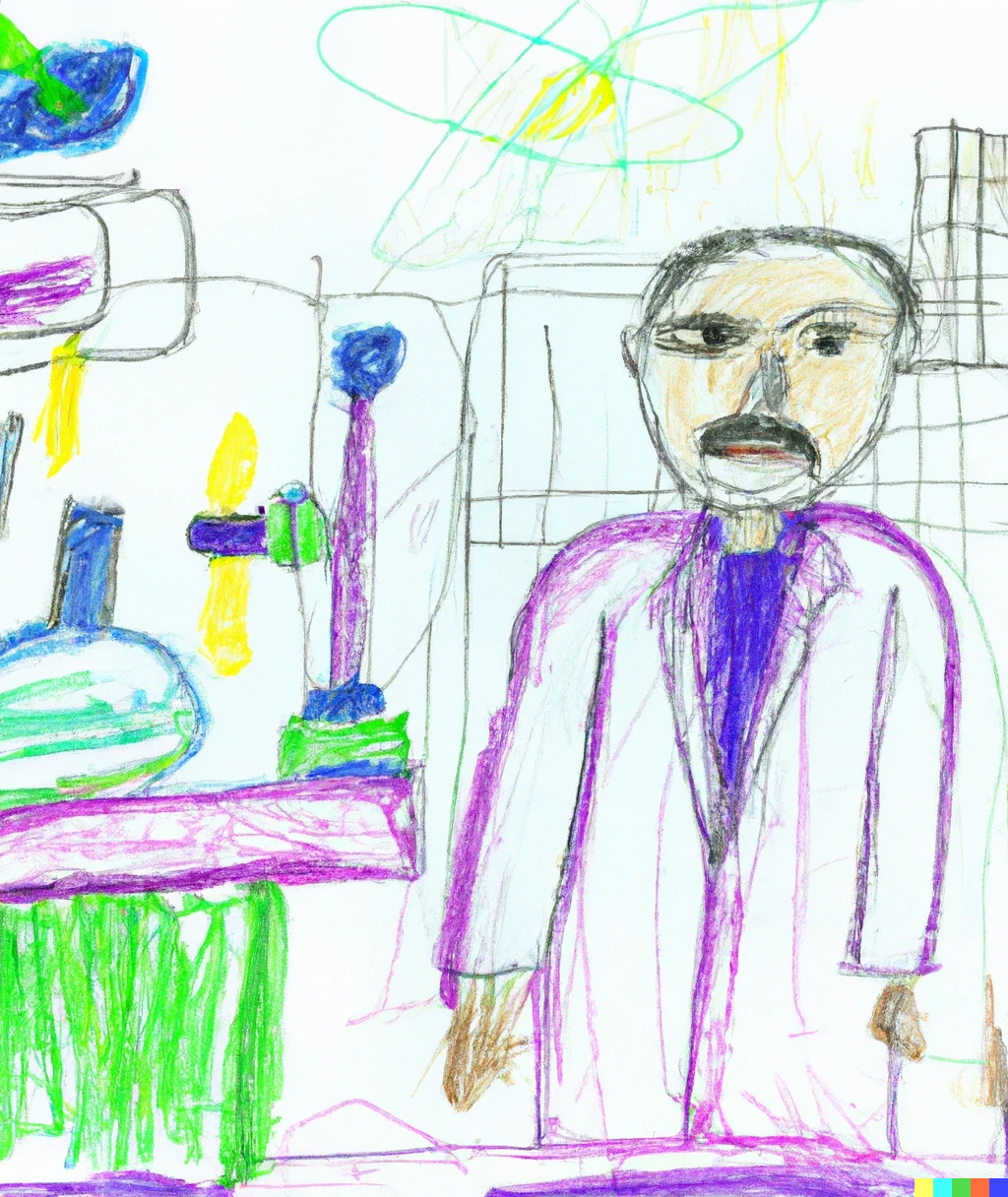
Image of a scientist in a lab (Let’s Talk Science using DALL-E AI).
Image - Text version
Shown is a childlike colour crayon drawing of a person with a moustache standing near beakers and test tubes.
The drawing uses bright, thick crayon marks on white paper. On the right is a person in a long white lab coat. They have pale skin, dark hair and a dark moustache. On the left is a green and purple table holding beakers and test tubes filled with colour. There are bright yellow streaks in the air above. In the background is a Rutherford atomic diagram, and black grids that could represent buildings or shelving.
Stereotypes such as those surrounding scientists, form from our experiences. Our brain likes to simplify and categorize things. This can create stereotypes if our source of input is small or narrow (e.g., TV and movies have tended to show white men in science leadership roles). For students, the sources of information relative to who or what a scientist is, are limited to their daily experiences. Television and movies make use of a number of stereotypes related to scientists to create interest in the product they are selling. In this way, they reinforce cultural stereotypes (e.g,, gender appropriateness of career choices) in youth who have no other means of seeing scientists in action.
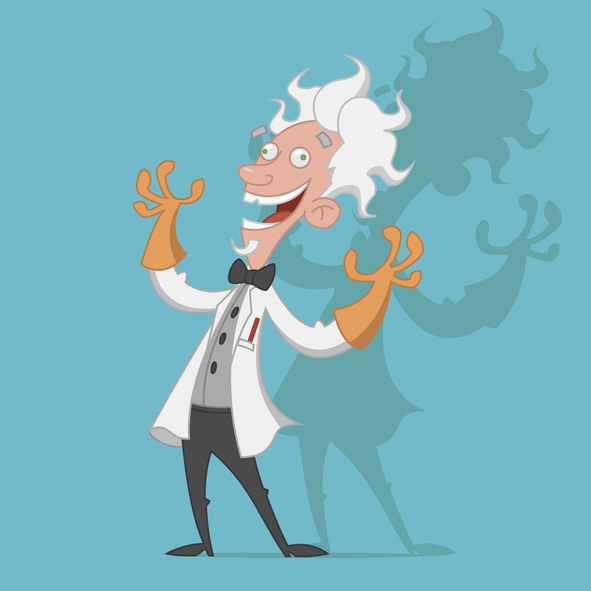
Stereotypical image of a scientist (Source: Gattsura via iStockphoto).
Image - Text version
Shown is a colour, cartoon-style illustration of a person with wild eyes, messy white hair, a lab coat and gloves.
The person is in the centre of the image. Their shadow is projected, large against the teal background. Their eyebrows are raised and their eyes point in two different directions. They have a wide, toothy grin. Their hair is big, curly and unkempt. They are stretching their arms up in the air. Their fingers spread out and curled in long orange gloves. They are wearing a black bowtie and a white lab coat with pens in the pocket.
A major disadvantage of stereotypes is that they can cause us to ignore differences between individuals. This can make us think things about people that might not be true. It can also cause us to think of ourselves in a particular manner and cause us to limit ourselves with respect to future opportunities. For example, if we do not see ourselves represented in the image of who a scientist is, or see our interests reflected in what they do, then we are unlikely to see this as an area for us. Providing students with the opportunity to discuss what they think scientists do, and who does science, helps them see beyond the limits that may have been imposed on them due to stereotyping.
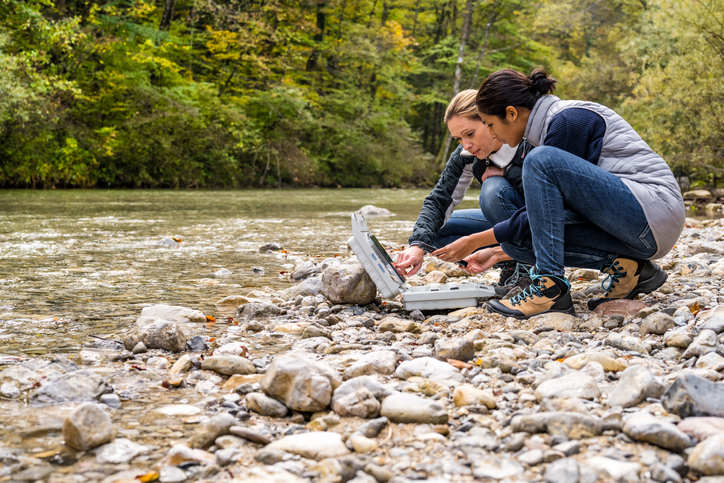
Scientists on the bank of a river (Source: vm via iStockphoto).
Image - Text version
Shown is a colour photograph of two young people crouched next to an open case on the shore of a river.
One person has long black hair tied in a bun. The other has long blond hair. Both are wearing jeans, hiking boots, and thermal vests. They have their hands in a small grey case, propped open on grey and beige rocks.
In the background is a wide, greenish river bordered by thick forest.
Additional Resources
Reproducibles
- Analyzing our Drawings reproducible [Google doc] [Word doc] [PDF]
- I Used to Think, Now I Think reproducible [Google doc] [Word doc] [PDF]
Videos
What Does a Scientist Look Like? Scientist Tools and Types of Scientists (2019)
This video (1:39 min.) from Hope Wins provides an elementary grade level introduction to the variety of science areas and the scientists who work in these areas.
How to be a scientist (2013)
This video (1:34 min.) from Mike Likes Science uses rap lyrics to what it takes to be a scientist.
Reproducibles and Media
Reproducibles
- Analyzing our Drawings reproducible [Google doc] [Word doc] [PDF]
- I Used to Think, Now I Think reproducible [Google doc] [Word doc] [PDF]
Videos
What Does a Scientist Look Like? Scientist Tools and Types of Scientists (2019)
This video (1:39 min.) from Hope Wins provides an elementary grade level introduction to the variety of science areas and the scientists who work in these areas.
How to be a scientist (2013)
This video (1:34 min.) from Mike Likes Science uses rap lyrics to what it takes to be a scientist.
Science
- Students could make drawings of themselves doing science.
- Students could explore various science careers and report back on what they have learned (i.e., the type of work being done, where the work is done, the tools used).
- Students could categorize various science-related careers based on the branch of science that is involved (e.g., biology, chemistry, earth/space science, physics).
- Students could develop and conduct a survey of others in their school to determine what the prevailing notion is of scientists doing science.
- Students could develop and conduct a survey to ascertain where people get their ideas of what scientists do, who they are, what they look like, etc.
Literacy
- Students could write a description of what they have drawn.
- Students could write a paragraph in which they describe “a scientist doing science” using what they have learned in this lesson.
- Students could read about well known scientists to learn about what they did at work, etc.
Mathematical Thinking
- Using the results of surveys, described above, students could identify the best ways to summarize and display their data using statistics and graphs.
Visual Arts
- Students could create an informational poster that demonstrates what a scientist doing science looks like.
Drama
- Students could write a play that addresses misconceptions about who scientists are and what they do.
Extensions
Science
- Students could make drawings of themselves doing science.
- Students could explore various science careers and report back on what they have learned (i.e., the type of work being done, where the work is done, the tools used).
- Students could categorize various science-related careers based on the branch of science that is involved (e.g., biology, chemistry, earth/space science, physics).
- Students could develop and conduct a survey of others in their school to determine what the prevailing notion is of scientists doing science.
- Students could develop and conduct a survey to ascertain where people get their ideas of what scientists do, who they are, what they look like, etc.
Literacy
- Students could write a description of what they have drawn.
- Students could write a paragraph in which they describe “a scientist doing science” using what they have learned in this lesson.
- Students could read about well known scientists to learn about what they did at work, etc.
Mathematical Thinking
- Using the results of surveys, described above, students could identify the best ways to summarize and display their data using statistics and graphs.
Visual Arts
- Students could create an informational poster that demonstrates what a scientist doing science looks like.
Drama
- Students could write a play that addresses misconceptions about who scientists are and what they do.
Eugster, P. (2007). The perceptions of scientists, The Science Creative Quarterly.
Kelly, L.B. (2018). Draw a Scientist: Uncovering students’ thinking about science and scientists. Science and Children, NSTA.
Snively, G. (2019). Chapter 9 – Changing Students’ Perceptions of Scientists, the Work of Scientists, and Who Does Science, in Knowing Home: Braiding Indigenous Science with Western Science, Book 1,Gloria Snively and Wanosts’a7 Lorna Williams (Editors).
Terada, Y. (2019). 50 years of children drawing scientists.
Wikipedia (2022). Draw-A-Scientist Test.
References
Eugster, P. (2007). The perceptions of scientists, The Science Creative Quarterly.
Kelly, L.B. (2018). Draw a Scientist: Uncovering students’ thinking about science and scientists. Science and Children, NSTA.
Snively, G. (2019). Chapter 9 – Changing Students’ Perceptions of Scientists, the Work of Scientists, and Who Does Science, in Knowing Home: Braiding Indigenous Science with Western Science, Book 1,Gloria Snively and Wanosts’a7 Lorna Williams (Editors).
Terada, Y. (2019). 50 years of children drawing scientists.
Wikipedia (2022). Draw-A-Scientist Test.
Reproducibles
- Analyzing our Drawings reproducible [Google doc] [Word doc] [PDF]
- I Used to Think, Now I Think reproducible [Google doc] [Word doc] [PDF]
Videos
What Does a Scientist Look Like? Scientist Tools and Types of Scientists (2019)
This video (1:39 min.) from Hope Wins provides an elementary grade level introduction to the variety of science areas and the scientists who work in these areas.
How to be a scientist (2013)
This video (1:34 min.) from Mike Likes Science uses rap lyrics to what it takes to be a scientist.
Reproducibles and Media
Reproducibles
- Analyzing our Drawings reproducible [Google doc] [Word doc] [PDF]
- I Used to Think, Now I Think reproducible [Google doc] [Word doc] [PDF]
Videos
What Does a Scientist Look Like? Scientist Tools and Types of Scientists (2019)
This video (1:39 min.) from Hope Wins provides an elementary grade level introduction to the variety of science areas and the scientists who work in these areas.
How to be a scientist (2013)
This video (1:34 min.) from Mike Likes Science uses rap lyrics to what it takes to be a scientist.
Science
- Students could make drawings of themselves doing science.
- Students could explore various science careers and report back on what they have learned (i.e., the type of work being done, where the work is done, the tools used).
- Students could categorize various science-related careers based on the branch of science that is involved (e.g., biology, chemistry, earth/space science, physics).
- Students could develop and conduct a survey of others in their school to determine what the prevailing notion is of scientists doing science.
- Students could develop and conduct a survey to ascertain where people get their ideas of what scientists do, who they are, what they look like, etc.
Literacy
- Students could write a description of what they have drawn.
- Students could write a paragraph in which they describe “a scientist doing science” using what they have learned in this lesson.
- Students could read about well known scientists to learn about what they did at work, etc.
Mathematical Thinking
- Using the results of surveys, described above, students could identify the best ways to summarize and display their data using statistics and graphs.
Visual Arts
- Students could create an informational poster that demonstrates what a scientist doing science looks like.
Drama
- Students could write a play that addresses misconceptions about who scientists are and what they do.
Extensions
Science
- Students could make drawings of themselves doing science.
- Students could explore various science careers and report back on what they have learned (i.e., the type of work being done, where the work is done, the tools used).
- Students could categorize various science-related careers based on the branch of science that is involved (e.g., biology, chemistry, earth/space science, physics).
- Students could develop and conduct a survey of others in their school to determine what the prevailing notion is of scientists doing science.
- Students could develop and conduct a survey to ascertain where people get their ideas of what scientists do, who they are, what they look like, etc.
Literacy
- Students could write a description of what they have drawn.
- Students could write a paragraph in which they describe “a scientist doing science” using what they have learned in this lesson.
- Students could read about well known scientists to learn about what they did at work, etc.
Mathematical Thinking
- Using the results of surveys, described above, students could identify the best ways to summarize and display their data using statistics and graphs.
Visual Arts
- Students could create an informational poster that demonstrates what a scientist doing science looks like.
Drama
- Students could write a play that addresses misconceptions about who scientists are and what they do.
Eugster, P. (2007). The perceptions of scientists, The Science Creative Quarterly.
Kelly, L.B. (2018). Draw a Scientist: Uncovering students’ thinking about science and scientists. Science and Children, NSTA.
Snively, G. (2019). Chapter 9 – Changing Students’ Perceptions of Scientists, the Work of Scientists, and Who Does Science, in Knowing Home: Braiding Indigenous Science with Western Science, Book 1,Gloria Snively and Wanosts’a7 Lorna Williams (Editors).
Terada, Y. (2019). 50 years of children drawing scientists.
Wikipedia (2022). Draw-A-Scientist Test.
References
Eugster, P. (2007). The perceptions of scientists, The Science Creative Quarterly.
Kelly, L.B. (2018). Draw a Scientist: Uncovering students’ thinking about science and scientists. Science and Children, NSTA.
Snively, G. (2019). Chapter 9 – Changing Students’ Perceptions of Scientists, the Work of Scientists, and Who Does Science, in Knowing Home: Braiding Indigenous Science with Western Science, Book 1,Gloria Snively and Wanosts’a7 Lorna Williams (Editors).
Terada, Y. (2019). 50 years of children drawing scientists.
Wikipedia (2022). Draw-A-Scientist Test.